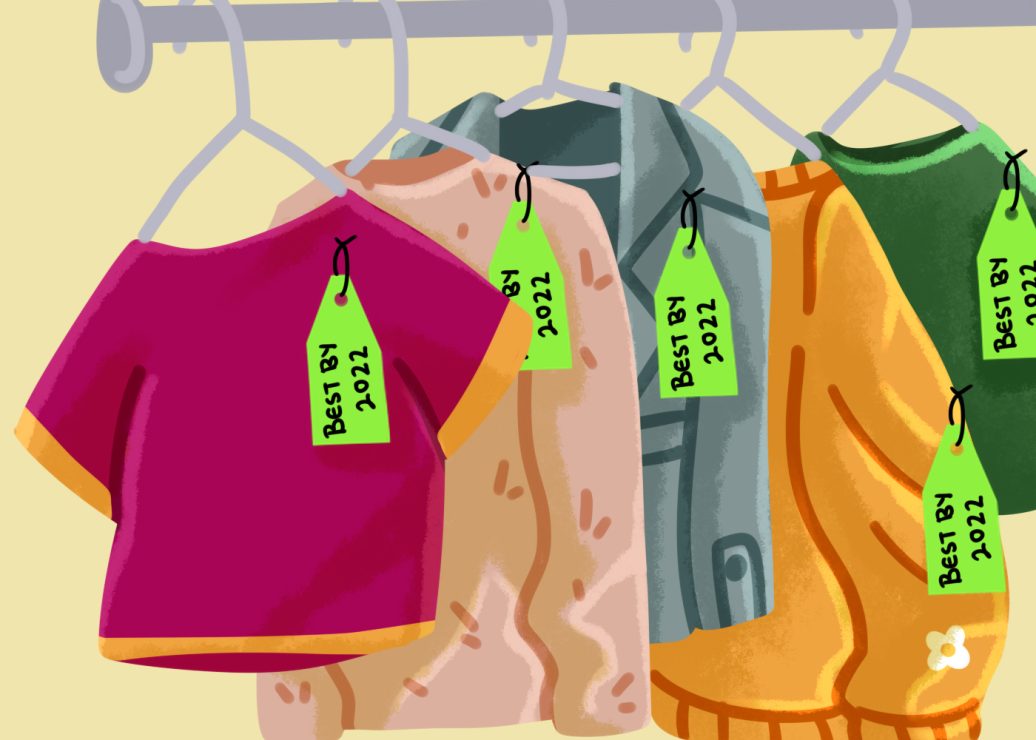How digital world views are changing consumption habits

Illustration by Sie Douglas-Fish.
I am suspicious that the way we interact with social media has a direct impact on our fast fashion consumption.
But first, a disclaimer. Because I don’t have the expertise or resources to conduct social or psychological research, this piece will, admittedly, utilize assumptions about our relationships to social media and our understanding of the world and contain my own theorizing. That being said, I hope you still find an idea or two of value.
Our social media feeds can dangerously appear to us like microcosms of the world, which is to say, sample sizes that “accurately” represent the greater society we live in. But in reality, these snapshots are algorithmically designed to reflect ourselves. This is, of course, not new information.
The Chicago School of Professional Psychology calls social media “the unreal world.” Rather than a separate-from-reality dystopia. Though, I suppose we feel more inclined to believe our feeds are a representation of the real world. I’ve personally been guilty of adopting this misconception in my own life.
Louis Rosenberg further explains this idea in an article for Big Think.
“The real problem is that social media distorts our perceptions of the public sphere,” writes Rosenberg. “By targeting users with droves of content meant to resonate specifically with them, it causes us to create a false mental model of society.”
The most drastic example of this I can think of is when I was sick and spent a couple of days in bed, passing more time on social media than I’d care to admit.
I had a high fever and viewed what I’d guess came close to thousands of photos and videos on Instagram, Pinterest, and Tiktok. The content was mostly created by teenage girls and young women — my demographic. When my fever subsided and I took my first trip to the grocery store, I found myself (ashamedly) almost surprised by the variety of people I saw.
I feel embarrassed admitting this, but I imagine I am not the only one who has been startled by reality after spending a reclusive few days deep in the digital world. I’ve taken to calling the phenomenon “microcosmic adaption dysphoria” because as we use social media, we adapt to accepting its portrayed reality as a microcosmic view of society — creating a sort of dysphoria for us in the real world. I’m sure there is a better name for it somewhere that I haven’t found.
This is all to say that I would argue this occurs on a certain level when we view our social media feeds. While the contrast between social media unreality and actual reality is not so stark when we interact with our accounts in moderation, a small amount of microcosmic adaption still must occur whenever we scroll. Assuming this is true, we can then consider how it might encourage consumerism.
In the 1980’s, trends fluctuated seasonally, and we could gauge what was “in” or “out” simply by observing those around us in our workplaces, classrooms, and social circles. “Everyone is wearing Converse,” a kid might have said to their mom after school, making a case for why they needed a pair too — because everyone was wearing them.
Now, because of the skewed sample sizes represented to us on our social media feeds, our understanding of “everyone” is compromised. “Everyone” could be one hundred or so people belonging to an online niche, but as long as it’s taking up your entire feed, your subconscious understanding of social media as an accurate representation of society doesn’t necessarily allow you to recognize that.
While our perception of society at large is skewed, our need to fit in with the masses remains part of the human condition. Because of this, we are buying more, more, more.
Would it not make sense then that the more time we spend on social media, the more at risk we are for microcosmic adaption and the further we stray from an accurate perception of society? And thus, the more likely we are to participate in fast fashion consumption in order to fit into the inaccurate, ever-changing sample size of society we see on our feeds?
Then, as the digital spaces we inhabit encourage behaviours like consumerism, the solution to the social and environmental harm caused by these consumption habits depends on changing our relationship to those spaces. Rather than fight the urge to purchase a new top from Shein and risk a feeling of non-belonging, it makes more sense to reconsider the conditions of our existences within the digital landscape.
Whether we are being affected by real-world or technological stimulation doesn’t change the way we react to it. If we perceive a norm or a need to fit in, we act on the impulse to do something about it — even when that information, coming from an algorithmic minutiae of the population for example, is inaccurate.
Then, differentiation between false representations of reality and a true understanding of the actual world we inhabit is up to you and me, and it starts with reconsidering our relationships to our feeds and what they represent to us.
Less time spent on social media seems like the obvious solution, but I find myself pushing back against that as a catch-all fix. I often detect, when people suggest less screen time to solve issues of media comprehension, an attitude of morally superior technological puritanism, which I resent. Not to mention, in an increasingly digital world, it’s not a practical solution.
What is more complicated to execute, but more reasonable, is this: a conscious re-acquaintance with social media, where we remind ourselves as we scroll that we are observing “the unreal world”, not a tiny model of what really comprises society. After all, with a change in perspective, our amazing brains have the power to re-shape our understanding of the world.








